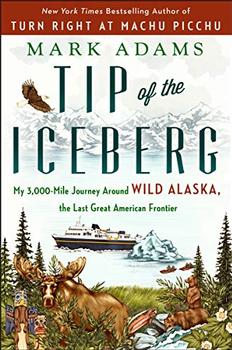Summary | Excerpt | Reviews | Beyond the Book | Read-Alikes | Genres & Themes | Author Bio

My 3,000-Mile Journey Around Wild Alaska, the Last Great American Frontier
by Mark AdamsThis article relates to Tip of the Iceberg
In Tip of the Iceberg, author Mark Adams sets out to follow in the footsteps of Edward Harriman's 1899 expedition to Alaska. Harriman's expedition is remembered for the important scientific findings gathered by the more than 30 scientists, artists and writers who accompanied him, but for Harriman himself, the focus was primarily on hunting bear. He eventually bagged his prize – a female Kodiak bear on Kodiak Island, much to the disgust of fellow traveler John Muir.
The Kodiak bear was identified as a unique subspecies of grizzly bear (aka "brown bear") by C. Hart Merriam, another member of the Harriman expedition, in 1896. They are the largest of the brown bears; an average male ("boar") stands five feet at the shoulder (10 feet tall when on its hind legs) and can weigh in at 1500 pounds, with females ("sows") averaging 20% smaller and 30% lighter than males. The only place on earth they can be found in the wild is the Kodiak Archipelago, a group of islands south of the Alaskan mainland comprised of approximately 5,300 square miles of land. This population has been isolated for about 12,000 years, which accounts for the genetic differences between this type of bear and those that dwell on the mainland. According to the Alaska Department of Fish and Game, the current population is thought to be about 3,500 animals, or about 0.7 bears per square mile.
 The Alutiiq natives of the Kodiak Archipelago hunted the Kodiaks ("Taquka'aq") as the only large land mammal available on the islands (deer, elk and reindeer were introduced during the 20th century). Before the appearance of firearms the tribe used bone arrows, slate spears, snares and deadfall traps to kill their prey. The Alutiiq Museum Archaeology Repository states, "In addition to meat and fat, bears provided gut for waterproof clothing, bone for tools, teeth for jewelry, and hides for bedding." The bear's head was usually left in the field as a sign of respect for the spirit of the animal.
The Alutiiq natives of the Kodiak Archipelago hunted the Kodiaks ("Taquka'aq") as the only large land mammal available on the islands (deer, elk and reindeer were introduced during the 20th century). Before the appearance of firearms the tribe used bone arrows, slate spears, snares and deadfall traps to kill their prey. The Alutiiq Museum Archaeology Repository states, "In addition to meat and fat, bears provided gut for waterproof clothing, bone for tools, teeth for jewelry, and hides for bedding." The bear's head was usually left in the field as a sign of respect for the spirit of the animal.
As Russians and other Caucasians migrated into the area, the bears were hunted for their hides. They were also considered a danger to the early settlers' cattle, and often large aggressive dogs were used for protection. At one point, a 9-foot fence bisecting Kodiak Island was contemplated as a way to create a bear-free zone, but the proposal was never enacted.
In the early 20th century, sport hunters flooded the island in search of trophy bears, and the bear population consequently plummeted. Concern over their potential extinction resulted in the stricter regulation of bear hunting and the creation of the Kodiak National Wildlife Refuge in 1941.
Bears are omnivores and spend more time eating grass, plants and berries than meat. They rarely expend the energy needed to chase down mammals for food, although during salmon spawning season, fish are a large portion of their diet. Due to the wide variety of food available on the island, Kodiak bears are less competitive and generally have smaller home ranges than other bear species. Animal density can be high in areas where the food supply is concentrated; as a result they've developed a complex communication and social structure to avoid fights.
The Alaska Department of Fish and Game considers the bear population healthy and stable due to the maintenance of a pristine habitat and a well-managed fish population. They issue just 496 hunting permits each year, and hunters outside Alaska are required to hire a professional guide (at $10,000-$21,000 per hunt). Each year, about 180 bears are killed, 70% of which are male. Although bear-human contact is on the rise, only one person is known to have been killed by a Kodiak bear in the past 75 years.
Kodiak bear
Filed under Nature and the Environment
![]() This "beyond the book article" relates to Tip of the Iceberg. It originally ran in July 2018 and has been updated for the
May 2019 paperback edition.
Go to magazine.
This "beyond the book article" relates to Tip of the Iceberg. It originally ran in July 2018 and has been updated for the
May 2019 paperback edition.
Go to magazine.
Your guide toexceptional books
BookBrowse seeks out and recommends the best in contemporary fiction and nonfiction—books that not only engage and entertain but also deepen our understanding of ourselves and the world around us.